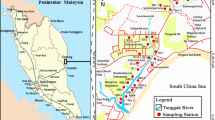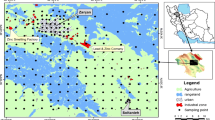Abstract
Contamination of heavy metals in soil is a matter of great concern, which can be evaluated collectively by environmental and multivariate statistical analysis. In this study, concentration of heavy metals was measured in the topsoil samples of Sehwan Sharif, district Jamshoro. Three groups of elements were produced from statistical analysis using Hierarchical dendrogram, Pearson correlation and Principal Component Analysis (PCA). First group included As, Cd, Ni and Zn while second contained B, Mn, Cu and Fe and the third one comprised of Pb and Cr. Greater values of RSD and abnormal distribution of other statistical analysis confirmed the source of Cd, Ni, As, Cr, Pb and Zn due to human activities while Fe, B, Mn, and Cu are due to natural abundance. Subsequently, the calculated Pollution Index (PI) for Cd, Ni and Pb was 1.08, 1.11 and 1.02 respectively, which was>1. The spatial maps were generated by Inverse Distance Weighting (IDW) interpolation technique in the GIS software which showed the hotspots of metal concentrations due to distinct sources from the environment such as highest content of Zn (157.07 ppm) was present in city center indicating its contamination due to emission from traffic. Furthermore, Potential Ecological Risk was estimated quantitatively and Risk Index map was generated, and it was observed that Cd showed higher potential ecological risk among the studied elements. However, the overall cumulative risk index was ‘considerable’ according to the potential ecological risk grade in the reported study.









Similar content being viewed by others
Data availability
The data that support this study will be shared on reasonable request to the corresponding author.
References
Adedeji, O., Olayinka, O., et al. (2020). Assessing spatial distribution, potential ecological and human health risks of soil heavy metals contamination around a Trailer Park in Nigeria. Scientific African, 10, e00650.
Adimalla, N., Qian, H., et al. (2020). Potentially toxic elements (PTEs) pollution in surface soils in a typical urban region of south India: An application of health risk assessment and distribution pattern. Ecotoxicology and Environmental Safety, 203, 111055.
Adriano, D. (2001). Trace Elements in Terrestrial Environments: Biogeochemistry, Bioavailability and Risks of Metals (p. 876). Springer.
Argyraki, A., & Kelepertzis, E. (2014). Urban soil geochemistry in Athens, Greece: the importance of local geology in controlling the distribution of potentially harmful trace elements. Science of The Total Environment, 482, 366–377.
Bux, R. K., Haider, S. I., et al. (2021). Assessment of heavy metal contamination and its sources in urban soils of district Hyderabad, Pakistan using GIS and multivariate analysis. International Journal of Environmental Science and Technology, 2021, 1–13.
Cetin, M., Aljama, A. M. O., et al. (2022a). Determination and mapping of regional change of Pb and Cr pollution in Ankara city center. Water, Air, & Soil Pollution, 233(5), 163.
Cetin, M., Aljama, A. M. O., et al. (2022b). Using topsoil analysis to determine and map changes in Ni Co pollution. Water, Air, & Soil Pollution, 233(8), 293.
Di Giuseppe, D., Antisari, L. V., et al. (2014). New insights on mobility and bioavailability of heavy metals in soils of the Padanian alluvial plain (Ferrara Province, northern Italy). Geochemistry, 74(4), 615–623.
Duan, X.-C., Yu, H.-H., et al. (2020). Geostatistical mapping and quantitative source apportionment of potentially toxic elements in top-and sub-soils: A case of suburban area in Beijing, China. Ecological Indicators, 112, 106085.
Elik, A. (2009). Atomic absorption determination of metals in superficial roadside soils using ultrasonic sample preparation. Asian Journal of Chemistry, 21(7), 5095.
Guo, G., Wu, F., et al. (2012). Spatial distribution and pollution assessment of heavy metals in urban soils from southwest China. Journal of Environmental Sciences, 24(3), 410–418.
Hakanson, L. (1980). An ecological risk index for aquatic pollution control. A sedimentological approach. Water research, 14(8), 975–1001.
Hamzeh, M. A., Aftabi, A., et al. (2011). Assessing geochemical influence of traffic and other vehicle-related activities on heavy metal contamination in urban soils of Kerman city, using a GIS-based approach. Environmental Geochemistry and Health, 33(6), 577–594.
Hou, D., O'Connor, D., et al. (2017). Integrated GIS and multivariate statistical analysis for regional scale assessment of heavy metal soil contamination: A critical review. Environmental Pollution, 231, 1188–1200.
Huang, Y., Chen, Q., et al. (2018). Heavy metal pollution and health risk assessment of agricultural soils in a typical peri-urban area in southeast China. Journal of environmental management, 207, 159–168.
Huang, Y., Deng, M., et al. (2018). A modified receptor model for source apportionment of heavy metal pollution in soil. Journal of hazardous materials, 354, 161–169.
Kazi, T. G., Jamali, M. K., et al. (2009). Evaluation of an ultrasonic acid digestion procedure for total heavy metals determination in environmental and biological samples. Journal of Hazardous Materials, 161(2-3), 1391–1398.
Li, J., Lu, Y., et al. (2009). Distribution of heavy metals in agricultural soils near a petrochemical complex in Guangzhou, China. Environmental monitoring and assessment, 153(1), 365–375.
Li, X., & Feng, L. (2012). Multivariate and geostatistical analyzes of metals in urban soil of Weinan industrial areas, Northwest of China. Atmospheric Environment, 47, 58–65.
Li, X., Lee, S.-L., et al. (2004). The study of metal contamination in urban soils of Hong Kong using a GIS-based approach. Environmental Pollution, 129(1), 113–124.
Manta, D. S., Angelone, M., et al. (2002). Heavy metals in urban soils: a case study from the city of Palermo (Sicily), Italy. Science of The Total Environment, 300(1-3), 229–243.
Matschullat, J., Ottenstein, R., et al. (2000). Geochemical background–can we calculate it? Environmental geology, 39(9), 990–1000.
Nag, R., O'Rourke, S. M., et al. (2022). A GIS study to rank Irish agricultural lands with background and anthropogenic concentrations of metal (loid) s in soil. Chemosphere, 286, 131928.
Negahban, S., Mokarram, M., et al. (2021). Ecological risk potential assessment of heavy metal contaminated soils in Ophiolitic formations. Environmental Research, 192, 110305.
Peng, H., Chen, Y., et al. (2022). Energy information flow-based ecological risk transmission among communities within the heavy metals contaminated soil system. Chemosphere, 287, 132124.
Penteado, J. O., de Lima Brum, R., et al. (2021). Health risk assessment in urban parks soils contaminated by metals, Rio Grande city (Brazil) case study. Ecotoxicology and Environmental Safety, 208, 111737.
Reimann, C., Filzmoser, P., et al. (2005). Background and threshold: critical comparison of methods of determination. Science of The Total Environment, 346(1-3), 1–16.
Romic, M., & Romic, D. (2003). Heavy metals distribution in agricultural topsoils in urban area. Environmental geology, 43(7), 795–805.
Sadeghi, M., Billay, A., et al. (2015). Analysis and mapping of soil geochemical anomalies: Implications for bedrock mapping and gold exploration in Giyani area, South Africa. Journal of Geochemical Exploration, 154, 180–193.
Sellami, S., Zeghouan, O., et al. (2022). Assessment of heavy metal pollution in urban and peri-urban soil of Setif city (High Plains, eastern Algeria). Environmental Monitoring and Assessment, 194(2), 126.
Shan, Y., Tysklind, M., et al. (2013). Identification of sources of heavy metals in agricultural soils using multivariate analysis and GIS. Journal of Soils and Sediments, 13(4), 720–729.
Shen, L., Zeng, J., et al. (2023). Source apportionment and risk assessment of heavy metals in urban soils from a central China city by using positive matrix factorization model coupled with Monte Carlo simulation. Stochastic Environmental Research and Risk Assessment, 37(1), 291–304.
Sun, Y., Zhou, Q., et al. (2010). Spatial, sources and risk assessment of heavy metal contamination of urban soils in typical regions of Shenyang, China. Journal of hazardous materials, 174(1-3), 455–462.
Tang, S., Yang, K., et al. (2022). Overview of heavy metal pollution and health risk assessment of urban soils in Yangtze River Economic Belt, China. Environmental Geochemistry and Health, 2022, 1–43.
Tepanosyan, G., Sahakyan, L., et al. (2016). Origin identification and potential ecological risk assessment of potentially toxic inorganic elements in the topsoil of the city of Yerevan, Armenia. Journal of Geochemical Exploration, 167, 1–11.
Tepanosyan, G., Sahakyan, L., et al. (2021). Identification of spatial patterns, geochemical associations and assessment of origin-specific health risk of potentially toxic elements in soils of Armavir region, Armenia. Chemosphere, 262, 128365.
Wang, M., Bai, Y., et al. (2012). A GIS technology based potential eco-risk assessment of metals in urban soils in Beijing, China. Environmental Pollution, 161, 235–242.
Wang, Z., Xiao, J., et al. (2020). Elucidating the differentiation of soil heavy metals under different land uses with geographically weighted regression and self-organizing map. Environmental Pollution, 260, 114065.
Ward, J. H., Jr. (1963). Hierarchical grouping to optimize an objective function. Journal of the American statistical association, 58(301), 236–244.
Wu, W., Wu, P., et al. (2018). Assessment of heavy metal pollution and human health risks in urban soils around an electronics manufacturing facility. Science of The Total Environment, 630, 53–61.
Yang, P., Drohan, P. J., et al. (2020). Spatial variability of heavy metal ecological risk in urban soils from Linfen, China. Catena, 190, 104554.
Yang, Q., Li, Z., et al. (2018). A review of soil heavy metal pollution from industrial and agricultural regions in China: Pollution and risk assessment. Science of The Total Environment, 642, 690–700.
Yuan, G.-L., Sun, T.-H., et al. (2014). Source identification and ecological risk assessment of heavy metals in topsoil using environmental geochemical mapping: typical urban renewal area in Beijing, China. Journal of Geochemical Exploration, 136, 40–47.
Zhang, X., Eto, Y., et al. (2021). Risk assessment and management of PM2. 5-bound heavy metals in the urban area of Kitakyushu, Japan. Science of The Total Environment, 795, 148748.
Zhang, X., Zha, T., et al. (2018). Spatial distribution of metal pollution of soils of Chinese provincial capital cities. Science of The Total Environment, 643, 1502–1513.
Zhou, J., Feng, K., et al. (2016). Multivariate analysis combined with GIS to source identification of heavy metals in soils around an abandoned industrial area, Eastern China. Ecotoxicology, 25(2), 380–388.
Zuzolo, D., Cicchella, D., et al. (2020). Potentially toxic elements in soils of Campania region (Southern Italy): Combining raw and compositional data. Journal of Geochemical Exploration, 213, 106524.
Acknowledgement
Not applicable.
Funding
Not applicable.
Author information
Authors and Affiliations
Corresponding author
Ethics declarations
Conflict of Interest
All authors declare no conflict of interest.
Additional information
Publisher’s Note
Springer Nature remains neutral with regard to jurisdictional claims in published maps and institutional affiliations.
Rights and permissions
Springer Nature or its licensor (e.g. a society or other partner) holds exclusive rights to this article under a publishing agreement with the author(s) or other rightsholder(s); author self-archiving of the accepted manuscript version of this article is solely governed by the terms of such publishing agreement and applicable law.
About this article
Cite this article
Bux, R.K., Batool, M., Shah, S.M. et al. Mapping the Spatial distribution of Soil heavy metals pollution by Principal Component Analysis and Cluster Analyses. Water Air Soil Pollut 234, 330 (2023). https://doi.org/10.1007/s11270-023-06361-1
Received:
Accepted:
Published:
DOI: https://doi.org/10.1007/s11270-023-06361-1




